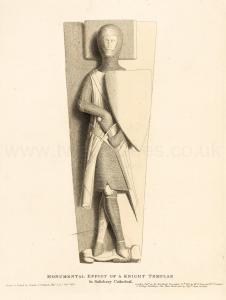Effigy of William Longespee The Younger
Effigy of William Longespee The Younger is in Monumental Effigies of Great Britain.
THIS effigy is on the south side of the nave of Salisbury Cathedral [Map]; it is ascribed, with some uncertainty, to William, eldest son of William Longespee, Earl of Salisbury, by his wife Ela. He was girt with the sword of knighthood in 1233, but could not enforce his claim with King Henry III. to succeed his father as Earl of Salisbury. He married Idonea, daughter and heiress of Richard de Camville. He took the cross, joined the expedition of St. Louis to the Holy Land, and after many deeds of valour, perished in 1250, in an engagement with the Saracens at a fortress called Massourah, between Damietta and Cairo. Matthew Paris, and a poem recently publisheda, which accord together in the main particulars, give a circumstantial relation of the manner of his death. It appears that great jealousy of Longespee and his English companions was entertained by the Count d'Artois, who, on more than one occasion, derided them as a race to whom the curse of Heaven adhered in the form of tails of beasts alluding to the ridiculous legend of St. Augustine and the Kentish boors. The Count d'Artois urged, with many sneers at the Templars and their master, and many vulgar taunts at Longespee, similar to those described, an attack on the fortified town of Mansour or Massourah. The gallant Englishman exclaimed, "Lead on, Sir Count, I will set my foot in danger thus far to day that you shall not dare to touch a hair even of my horse's tail according to your vulgar jest." The Christians rushed forward into the fortress, where they met with so warm a reception that the Count d'Artois was the first to fly, and plunging his horse into the neighbouring river, perished by the weight of his harness in his attempt to escape. Longespee resisted all proposals of retreat, "Never," said he, "shall the son of my father flee before a Saracen!" Supported by a few knights, and surrounded by a host of infidels, his valour could purchase nothing for itself but honourable death. His right foot at first was cut off; sustained by Richard de Ascalon he still fought on; a Saracen sabre disabled his right arm, he grasped his sword in his left hand until that also was separated from his body. Then fell the valiant grandson of Plantagenet, and on his honoured corpse fell also Richard de Ascalon and De Guise his banner-bearer, disdaining to survive a master so noble. He was interred in the church of St. Cross at Acre, and it is conjectured that his mother Ela, the Abbess of Laycock, caused this monument to be placed in the cathedral of Salisbury to his memory. The figure is in the attitude of a Crusader, and the style of its costume very well agrees with the period in which Longespee the younger died. The hauberk, which before this time was entirely of chain mail, has now portions of plate armour attached, covering the knees and elbows. The triangular shield with curved sides, reaches, now, only from the shoulder to the middle of the thigh.
Note a. See Matt. Paris, edit. Watts, pp. 785, 791. Excerpta Historica. Bentiey, 1830, p. 66.
